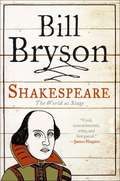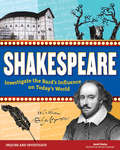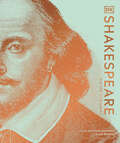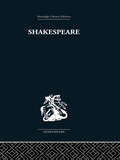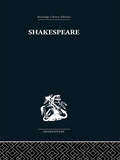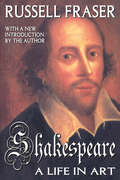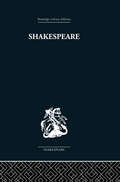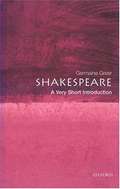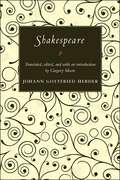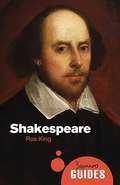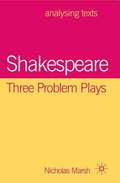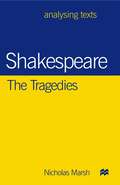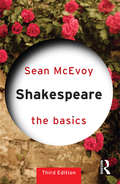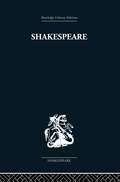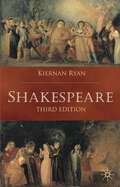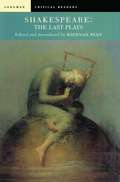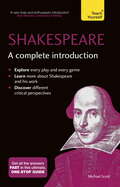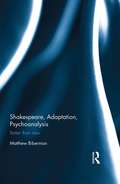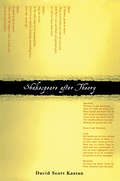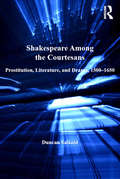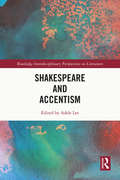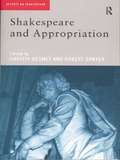- Table View
- List View
Shakespeare: The World as Stage
by Bill BrysonAmerican native Bryson, alive and well in England, sets out what little is known about the life of the Elizabethan playwright and samples the voluminous scholarship about his work and its influence on English as a language and a body of literature. His approach is lighthearted and non-technical. Annotation ©2008 Book News, Inc., Portland, OR (booknews.com)
Shakespeare
by Andi Diehn"Romeo, Romeo, wherefore art thou Romeo?” Teenagers have been sighing an approximation of these words for centuries, ever since William Shakespeare had Juliet utter them from her balcony in one of the most popular plays of all time, Romeo and Juliet. Tales of love, loss, rebellion, rivalry--before there was Twilight, Warm Bodies, and The Lion King, there was Shakespeare. The characters, language, imagery, and plot elements of many books and movies that appear on bookshelves and in cinemas today are directly influenced by the plays of the Bard. In Shakespeare: Investigate the Bard’s Influence on Today’s World, readers discover links between the books, movies, and music they listen to today and the words that were written and acted out more than 400 years ago. Readers deconstruct Shakespearean themes, imagery, language, and meaning by finding familiar ground on which to gain literary insight. Through hands-on projects such as coding a video game based on one of Shakespeare’s plays to rewriting a scene in the text language of emoji, readers find compelling avenues into the dramatic, sometimes intimidating language, leaving them well-equipped to tackle any major text in the academic years to come.
Shakespeare: Investigate the Bard's Influence on Today's World
by Andi Diehn Samuel Carbaugh"Romeo, Romeo, wherefore art thou Romeo?" Teenagers have been sighing an approximation of these words for centuries, ever since William Shakespeare had Juliet utter them from her balcony in one of the most popular plays of all time, Romeo and Juliet. Tales of love, loss, rebellion, rivalry-before there was Twilight, Warm Bodies, and The Lion King, there was Shakespeare. The characters, language, imagery, and plot elements of many books and movies that appear on bookshelves and in cinemas today are directly influenced by the plays of the Bard.In Shakespeare: Investigate the Bard's Influence on Today's World, readers discover links between the books, movies, and music they listen to today and the words that were written and acted out more than 400 years ago. Readers deconstruct Shakespearean themes, imagery, language, and meaning by finding familiar ground on which to gain literary insight. Through hands-on projects such as coding a video game based on one of Shakespeare's plays to rewriting a scene in the text language of emoji, readers find compelling avenues into the dramatic, sometimes intimidating language, leaving them well-equipped to tackle any major text in the academic years to come.
Shakespeare
by Mark Van Doren34 chapters of critical and interpretative comment on each of the Bard's plays with another chapter on his poems
Shakespeare: His Life and Works (DK Ultimate Guides)
by Leslie Dunton-Downer Alan RidingA comprehensive collection of the life and works of a literary great — William Shakespeare!The beautifully illustrated guide unravels the life and works of Shakespeare and his plays, from language, history, and themes to plays, poems, and sonnets. Explore the art of this famous playwright and his enduring legacy through the stunning gift format.Celebrate one of the theaters most influential contributors through his legendary works of comedy, tragedy, romance, and poetry. Inside this playbook, you&’ll find: • A clear and accessible format. • Plot summaries of all 39 plays with lists of characters. • Guidance on how to read and interpret his great sonnets and narrative poems. • Plays ordered by time and genre, helping readers trace the development of Shakespeare&’s topics, themes, and artistry. • Sidebars that clarify the mythological, geographical and historical context of each play and decode its language, dramatic action, and themes. • Illuminated guidance on how to approach reading the play and seeing it perform.Shakespeare fans will revel in the marvelous depiction of the Stratford-upon-Avon born Bard himself! His drama book allows you to dive into famous works like Hamlet, Romeo and Juliet, and A Midsummer Night&’s Dream, and explore Shakespeare&’s sources and inspirations for each! Themes, plots, characters, and language are brought to life with act-by-act plot summaries, resumes of main characters, and in-depth analysis of Shakespeare&’s use of the English language. Shakespeare: His Life and Works is a wonderful exploration of plays, poems, and sonnets in the context of his life and the Elizabethan and Jacobean theatre, further enriching your on the page (or stage, or screen!) experience.
Shakespeare: The Cambridge Dover Wilson Shakespeare (cambridge Library Collection. Literary Studies) (Cambridge Dover Wilson Shakespeare Ser. #Vol. 17)
by George Ian DuthieFirst published in 1951. 'The book has the sterling qualities of shrewd sense and acumen that mark the 'rational' classical school of Shakespeare criticism.' Notes and Queries 'Professor Duthie's approach is direct and extremely objective. With no axe to grind, he pays impartial court to most of the great schools of Shakespearian criticism.' Cambridge Daily News 'Professor Duthie has much to say that is wise and judicious'. Times Literary Supplement. Contents include: Shakespeare's Characters and Truth to Life; Shakespeare and the Order-Disorder Antithesis; Comedy; Imaginative Interpretation and Troilus and Cressida; History; Tragedy; The Last Plays.
Shakespeare: The Dark Comedies to the Last Plays: from satire to celebration (Shakespeare Survey Ser. #44)
by R A FoakesFirst published in 1971. This volume explains and analyses the last plays of Shakespeare as dramatic structures. Beginning from the dark comedies, the author describes the ways in which Shakespeare was affected by the new techniques and possibilities for drama opened up by the innovations of the years after 1600, notably by the rise in children's companies. The main line of development of Shakespeare's dramatic skills is shown as leading from the dark comedies, through the late tragedies, to the last plays. A major part of the book is devoted to analyses of Cymbeline, The Winter's Tale, The Tempest and King Henry VIII.
Shakespeare: A Life in Art
by Russell FraserShakespeare: A Life in Art brings together in a single volume Fraser's previously published two-volume biography (Young Shakespeare, 1988, and Shakespeare: The Later Years, 1992). This volume includes a new introduction, which looks back on the author's lifelong commitment to Shakespeare's work and seeks to find the pattern in his carpet.Fraser's approach places Shakespeare's work first but shows how the life and art interpenetrate, like the yolk and white of one shell. What Shakespeare was doing in Stratford and London underlies what he was writing, or more exactly, the two flow together. Most of the book is devoted to Shakespeare the man and artist, but it simultaneously throws light on his literary and personal relations with contemporaries such as Jonson, Marlowe, and others known as the University Wits. His experience as an actor and man of theater is absorbingly recounted here, as well as his relations to well-born patrons like the Earl of Southampton and Henry Carey, Lord Hunsdon (England's Lord Chamberlain). In 1603 when James I ascended the throne, the Chamberlain's Men became the King's Men, passing under the sovereign's protection. How Shakespeare responded to his ambiguous role--he was both servant to the great and their remorseless critic--is another of Fraser's subjects. In short, Fraser's principal purpose is to advance our understanding of Shakespeare, at the same time throwing light on the work of the man who of all modern, and perhaps ancient poets had the largest and most comprehensive soul. John Dryden, Shakespeare's first great critic, said that, and Fraser tries to estimate what he meant.
Shakespeare: The art of the dramatist (Princeton Legacy Library #1782)
by Roland Mushat FryeThis edition first published in 1982. Previous edition published in 1972 by Houghton Mifflin. Outlining methods and techniques for reading Shakespeare's plays, Roland Frye explores and develops a comprehensive understanding of Shakespeare's drama, focussing on the topics which must be kept in mind: the formative influence of the particular genre chosen for telling a story, the way in which the story is narrated and dramatized, the styles used to convey action, character and mood, and the manner in which Shakespeare has constructed his living characterizations. As well as covering textual analysis, the book looks at Shakespeare's life and career, his theatres and the actors for whom he wrote and the process of printing and preserving Shakespeare's plays. Chapters cover: King Lear in the Renaissance; Providence; Kind; Fortune; Anarchy and Order; Reason and Will; Show and Substance; Redemption and Shakespeare's Poetics.
Shakespeare: A Very Short Introduction
by Germaine GreerA clear introduction to Shakespeare's plays, this volume examines them in detail and shows how Shakespeare dramatized moral and intellectual issues in such a way that his audience became dazzlingly aware of an imaginative dimension to daily life. Germaine Greer argues that as long as Shakespeare's work remains central to English cultural life, it will retain the values which make it unique in the world.
Shakespeare
by Johann Gottfried HerderWithout Johann Gottfried Herder (1744–1803), we simply would not understand Shakespeare in the way we do. In fact, much literature and art besides Shakespeare would neither look the same nor be the same without the influence of Herder's "Shakespeare" (1773). One of the most important and original works in the history of literary criticism, this passionate essay pioneered a new, historicist approach to cultural artifacts by arguing that they should be judged not by their conformity to a set of conventions imported from another time and place, but by the effectiveness of their response to their own historical and cultural context. Rejecting the authority of a dominant and stifling French neoclassicism that judged eighteenth-century plays by the criteria of Aristotle, Herder's "Shakespeare" signaled a break with the Enlightenment, the approach of Romanticism, and the arrival of a distinctly modern form of aesthetic appreciation.With a vivid new translation and a fascinating introduction by Gregory Moore, this edition of Herder's classic will speak to today's readers with undiminished power and persuasiveness.
Shakespeare: A Beginner's Guide (Beginner's Guides)
by Ros KingWhether the fault of tedious teachers or hammy actors, Shakespeare is often seen as dry and impenetrable. In this fast-paced introduction, Ros King sets out to remind us of the sheer beauty and sophistication that can make Shakespeare's works a joy for any audience. Exploring his invention, wit, along with his uncanny characterisation, King argues archaic language should be no barrier to the modern reader. With summaries of The Bard's life and background, explanations of the plays' origins and instructions on how to read his poetry, Shakespeare: A Beginner's Guide provides all the tools the general reader needs to embrace the greatest writer in the English language.
Shakespeare: Three Problem Plays (Analysing Texts Ser.)
by Nicholas MarshWritten in 1602-4, between Hamlet and the other great tragedies, Shakespeare's three Problem Plays are so called because they do not fit easily into the other groups of plays. They are awkward dramas, full of unresolved controversies, which leave audiences and readers unsettled by contradictory responses. Nicholas Marsh uses close analysis of extracts from the plays to explore how Shakespeare maintains competing discourses within a single text. In the first part of his study, Marsh highlights the multiple interpretations these plays provoke and provides useful sections on methods of analysis to encourage readers to develop their views independently. The second part of the book discusses the Problem Plays in relation to the playwright's other works, and examines their cultural and historical contexts. A comparison of five modern critical views and helpful suggestions for further reading provide a bridge to continuing study. In this essential guide to a complex set of plays, Marsh does not seek to reconcile the thorny issues these dramas leave open: rather, he equips the reader with the necessary critical tools to fashion their own synthesis.
Shakespeare: The Tragedies (Analysing Texts)
by Nicholas MarshThought of as Shakespeare's most powerful works, the four great tragedies, Hamlet, King Lear, Othello and Macbeth, are texts of unparalleled richness and depth, stimulating and exciting to study. This book takes extracts and examines them, explaining how the critic can use particular techniques to bring out complexities of meaning, understand the patterns of metaphor and the rhythms of the poetry and appreciate the ever-living drama. Chapters on the openings and endings of plays, heroes and heroines, society, humour, imagery and the tragic universe guide the student on a journey of inquiry into the nature of Shakespeare's tragic vision. Far from simplifying Shakespeare, the reader is challenged to confront the depth and subtlety of the dramas, and to enjoy the analytical pursuit of ever finer insight, ever fuller understanding.
Shakespeare: The Basics (The Basics)
by Sean McEvoyNow in its third edition Shakespeare: The Basics is an insightful and informative introduction to the work of William Shakespeare. Exploring all aspects of Shakespeare’s plays including the language, cultural contexts, and modern interpretations, this text looks at how a range of plays from across the genres have been understood. Updates in this edition include: Ecocritical, queer, presentist and gendered discussions of Shakespeare’s work Studies of new performances including Tennant and Tate’s Much Ado About Nothing Critical discussions of race and politics in Othello and King Lear Case studies of modern film versions of Shakespeare’s works A chronology of Shakespeare’s work and contemporary events With fully updated further reading throughout and a wide range of case studies and examples, this text is essential reading for all those studying Shakespeare’s work.
Shakespeare (Shakespeare Survey Ser. #Series Number 7)
by Allardyce NicollFirst published in 1952. An invaluable introduction to Shakespeare, this book places Shakespeare's work and criticism against the background of Elizabethan life in its historical, social, political, religious, linguistic and literary aspects. Contents include: The Problem of Interpretation; Shakespeare at Work; Man and Society; Man and the Universe; The Inner Life.
Shakespeare
by Kiernan RyanFirst published in 1989, this 3rd edition, a critical study of Shakespeare, has been revised, updated and expanded with new material, so it is twice the size of the first edition. The section on Shakespearean comedy now includes an essay on Shakespeare's first scintillating experiment in the genre, The Comedy of Errors, and a study of his most perplexing problem play, Measure for Measure. ; A new last chapter, ' Dreaming on things to come - Shakespeare and the Future of Criticism, reveals how much modern criticism can learn from the appropriation of Shakespeare by Oscar Wilde, George Bernard Shaw and James Joyce
Shakespeare: The Last Plays (Longman Critical Readers)
by Kiernan RyanThis is the first collection of criticism on Shakespeare's romances to register the impact of modern literary theory on interpretations of these plays. Kiernan Ryan brings together the most important recent essays on Pericles, Cymbeline, The Winter's Tale and The Tempest, the greatest of the `last plays', staging a dynamic debate between feminist, poststructuralist, psychoanalytic and new historicist views of the masterpieces Shakespeare wrote at the close of his career.The book aims not only to anthologise accounts of the last plays by leading Shakespearean critics, including Stephen Greenblatt, Janet Adelman, Leah Marcus, Howard Felperin and Steven Mullaney, but also to dramatise what is at stake in the choice of a particular critical approach. It allows the student to compare the strengths and limitations of a deconstructive and a feminist reading of the same romance, or to test the plausibility of one psychoanalytic angle on the last plays against another. The headnotes that preface the essays highlight their distinctive slants on Shakespearean romance, unpack the theoretical assumptions that steer their interpretations, and throw into relief the key points at which their authors collide or converge.The editor's introduction places the essays in the context of twentieth-century criticism of the last plays and makes a powerful case for a fundamental reappraisal of Shakespearean romance. The comprehensive, fully annotated bibliography provides an unrivalled guide to further reading on all four plays.
Shakespeare: A Complete Introduction
by Michael ScottWritten by an academic and literary scholar with decades of experience in teaching Shakespeare to students at all levels, Shakespeare: A Complete Introduction is designed to give you everything you need to succeed, all in one place. It covers the key themes and critical concepts that students are expected to be confident in, outlining the ideas in clear jargon-free English, and then providing added-value features like key quotes, chapter recap sections, and even lists of questions you might be asked in your seminar or exam.The book organizes Shakespeare's work by genre and theme, in order to look closely at the individual plays. It opens with contextualizing information about the original texts, language usage, and how the plays were performed. The book is then grouped into the genres of early and romantic Comedies, Tragedies, Problem Plays, and the Histories. Each chapter will focus on one or two key plays, and foreground the themes and preoccupations that surround critical work on those plays. Throughout the book there will be an emphasis on the historical vs the contemporary approach, and the distinctions between literary and theatrical competencies.
Shakespeare, Adaptation, Psychoanalysis: Better than New
by Matthew BibermanIn Shakespeare, Adaptation, Psychoanalysis, Matthew Biberman analyzes early adaptations of Shakespeare’s plays in order to identify and illustrate how both social mores and basic human psychology have changed in Anglo-American culture. Biberman contests the received wisdom that Shakespeare’s characters reflect essentially timeless truths about human nature. To the contrary, he points out that Shakespeare’s characters sometimes act and think in ways that have become either stigmatized or simply outmoded. Through his study of the adaptations, Biberman pinpoints aspects of Shakespeare’s thinking about behavior and psychology that no longer ring true because circumstances have changed so dramatically between his time and the time of the adaptation. He shows how the adaptors’ changes reveal key differences between Shakespeare’s culture and the culture that then supplanted it. These changes, once grasped, reveal retroactively some of the ways in which Shakespeare’s characters do not act and think as we might expect them to act and think. Thus Biberman counters Harold Bloom’s claim that Shakespeare fundamentally invents our sense of the human; rather, he argues, our sense of the human is equally bound up in the many ways that modern culture has come to resist or outright reject the behavior we see in Shakespeare’s plays. Ultimately, our current sense of 'the human' is bound up not with the adoption of Shakespeare’s psychology, perhaps, but its adaption-or, in psychoanalytic terms, its repression and replacement.
Shakespeare After Theory
by David Scott KastanThe most familiar assertion of Shakespeare scholarship is that he is our contemporary. Shakespeare After Theory provocatively argues that he is not, but what value he has for us must at least begin with a recognition of his distance from us.
Shakespeare, Alchemy and the Creative Imagination
by Margaret HealyShakespeare's Sonnets and A Lover's Complaint constitute a rich tapestry of rhetorical play about Renaissance love in all its guises. A significant strand of this is spiritual alchemy: working the 'metal' of the mind through meditation on love, memory work and intense imagination. Healy demonstrates how this process of anguished soul work - construed as essential to inspired poetic making - is woven into these poems, accounting for their most enigmatic imagery and urgency of tone. The esoteric philosophy of late Renaissance Neoplatonic alchemy, which embraced bawdy sexual symbolism and was highly fashionable in European intellectual circles, facilitated Shakespeare's inscription of an interior drama of a desiring mind creating poetry. Arguing that Shakespeare's incorporation of alchemical textures throughout his late works is indicative of an artistic stance promoting religious toleration and unity, this book sets out a crucial new framework for interpreting the 1609 poems, and transforms our understanding of Shakespeare's art.
Shakespeare Among the Courtesans: Prostitution, Literature, and Drama, 1500-1650 (Anglo-Italian Renaissance Studies)
by Duncan SalkeldCourtesans - women who achieve wealth, status, or power through sexual transgression - have played both a central and contradictory role in literature: they have been admired, celebrated, feared, and vilified. This study of the courtesan in Renaissance English drama focuses not only on the moral ambivalence of these women, but with special attention to Anglo-Italian relations, illuminates little known aspects of their lives. It traces the courtesan from a wry comedic character in the plays of Terence and Plautus to its literary exhaustion in the seventeenth-century dramatic works of Dekker, Marston, Webster, Middleton, Shirley and Brome. The author focuses especially on the presentation of the courtesan in the sixteenth century - dramas by Shakespeare, Marlowe, and Lyly view the courtesan as a symbol of social disease and decay, transforming classical conventions into English prejudices. Renaissance Anglo-Italian cultural and sexual relations are also investigated through comparisons of travel narratives, original source materials, and analysis of Aretino's representations of celebrated Italian courtesans. Amid these fascinating tales of aspiration, desire and despair lingers the intriguing question of who was the 'dark lady' of Shakespeare's sonnets.
Shakespeare and Accentism (Routledge Interdisciplinary Perspectives on Literature)
by Adele LeeThis collection explores the consequences of accentism—an under-researched issue that intersects with racism and classism—in the Shakespeare industry across languages and cultures, past and present. It adopts a transmedia and transhistorical approach to a subject that has been dominated by the study of "Original Pronunciation." Yet the OP project avoids linguistically "foreign" characters such as Othello because of the additional complications their "aberrant" speech poses to the reconstruction process. It also evades discussion of contemporary, global practices and, underpinning the enterprise, is the search for an aural "purity" that arguably never existed. By contrast, this collection attends to foreign speech patterns in both the early modern and post-modern periods, including Indian, East Asian, and South African, and explores how accents operate as "metasigns" reinforcing ethno-racial stereotypes and social hierarchies. It embraces new methodologies, which includes reorienting attention away from the visual and onto the aural dimensions of performance.
Shakespeare and Appropriation: George Eliot, A. C. Swinburne, Robert Browning, And Charles Dickens (Accents on Shakespeare)
by Christy Desmet Robert SawyerThe vitality of our culture is still often measured by the status Shakespeare has within it. Contemporary readers and writers continue to exploit Shakespeare's cultural afterlife in a vivid and creative way. This fascinating collection of original essays shows how writers' efforts to imitate, contradict, compete with, and reproduce Shakespeare keep him in the cultural conversation. The essays: * analyze the methods and motives of Shakespearean appropriation * investigate theoretically the return of the repressed author in discussions of Shakespeare's cultural function * put into dialogue theoretical and literary responses to Shakespeare's cultural authority * analyze works ranging from nineteenth century to the present, and genres ranging from poetry and the novel to Disney movies.
